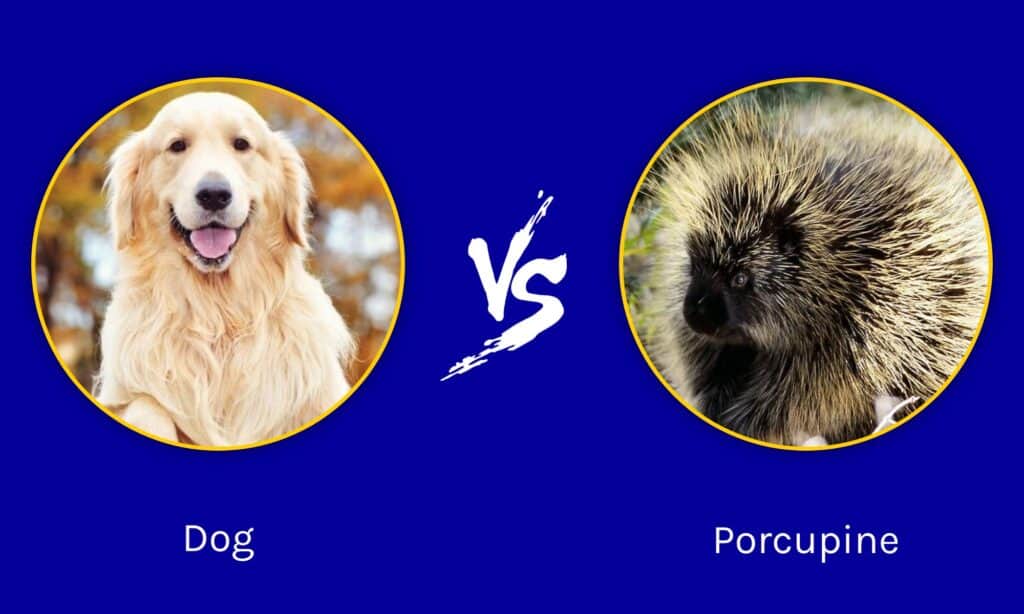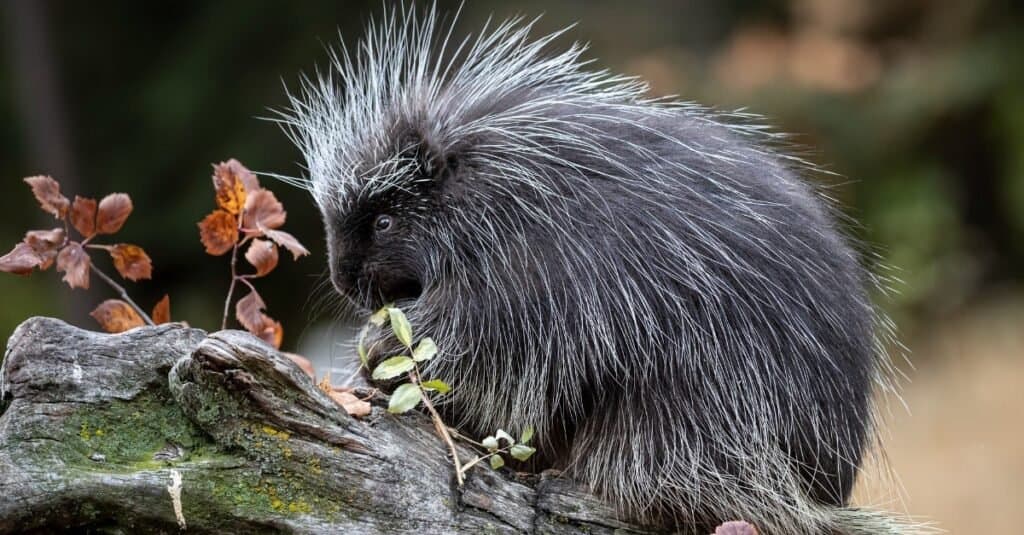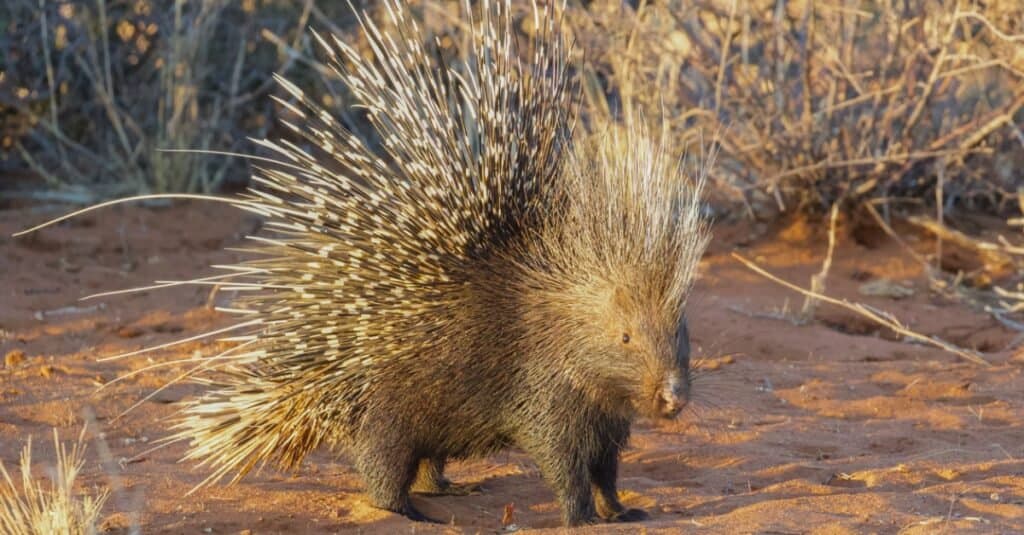Dogs are man’s best friend, but they have a bad habit of going after animals they have no business fighting. One of the many creatures that dogs can come into contact with is the porcupine, a rodent that can stick sharp quill barbs into their foes. In a dog vs porcupine fight, who wins? Determining the winner of this bout is going to require closely examining each animal’s differences and advantages.
Since dogs can range in size, we’re going to use the statistics about one of the most popular breeds, golden retrievers. That way, we can determine what happens with an average dog in this battle.
Comparing a Dog and a Porcupine

| Dog | Porcupine | |
|---|---|---|
| Size | Weight: 55lbs-75lbs Height: 1.6ft-2ft shoulder height Length: 3ft-3.5ft | Weight: 12lbs-35lbs Height: 1ft-1.5ft Length: 1.2ft-2.5ft |
| Speed and Movement Type | – 25-35 mph | – 2 mph |
| Defenses | – Speed and agility – Growling threat display – Great senses to recognize threats | – Sharp quills – Composed of special hairs coated with keratin – Some porcupines have groups of quills, and others have single quills spread out in their hair – Can raise quills as part of a threat display – Threat display includes quill erection, tail rattling, growling, and then a physical attack. |
| Offensive Capabilities | – Moderately powerful jaws – 42 teeth – Somewhat sharp, strong canine teeth | – Can flare their quills and walk backward to force animals to move in a certain direction – Recent study shows these mammals running into other animals in an attempt to kill – Only try to kill with quills in a dire situation or when they outnumber their foes |
| Predatory Behavior | – Pursuit predators of some animals – Domesticated dogs aren’t keen predators like wild dogs or the wolves from which they evolved | – Herbivorous diet leads to no predatory behavior |
What Are Key Differences Between a Dog and a Porcupine?

Porcupines are small rodents that can deliver painful quill injuries.
©iStock.com/Carol Gray
The greatest differences between a dog and a porcupine are morphological in nature. For example, dogs are canines with medium-length fur weighing between 55lbs and 75lbs, standing 2ft at the shoulder and measuring about 3.5ft in length, but porcupines are rodents with quills integrated into their fur that weigh between 12lbs and 25lbs, stand just over 1ft tall and measure perhaps 2.5ft long.
The differences between dogs and porcupines are significant. We must examine these animals according to their differences and other major factors and see how they could potentially influence the fight.
What Are the Key Factors in a Fight Between a Dog and a Porcupine?

Golden retrievers have predatory instincts and curiosity that can get them into trouble with porcupines.
©iStock.com/Abenfield1
The most important factors in a battle between a dog and a porcupine are their size, speed, and the way they attack. Both animals differ in just about every category in those respects. However, it’s necessary to explore these facets of the animals in-depth and find out which creature has the most advantages over the other. Only then can we determine which animal has the best opportunity to survive this conflict.
Dog vs Porcupine: Size
Dogs are larger than porcupines. A dog can grow up to weigh 75lbs while standing 2ft tall at the shoulders and growing 3.5ft long. However, a porcupine only grows up to 35lbs, 1.5ft in height, and 2.5ft long. In the animal kingdom, it’s most often the larger animal that wins a battle.
Dogs have the size advantage.
Dog vs Porcupine: Speed and Movement
A dog is faster than a porcupine. A porcupine can move around 2 mph, but dogs can run at speeds up to 35 mph. Also, dogs have a lot of agility to move around and dodge other creatures.
Dogs have the speed advantage.
Dog vs Porcupine: Defenses
Porcupines have amazing defenses compared with dogs. Porcupines have sharp quills throughout their fur. When animals try to attack porcupines, the quills stick in their skin and break off.
Porcupines have a threat display that includes flaring their quills, rattling their tails, growling, and then trying to run backwards or sideways into enemies.
Dogs don’t have much in the way of defenses aside from their speed, threat display, and great senses. They can get away from trouble before it begins, but dogs’ fur and skin aren’t very protective.
Porcupines have the defensive advantage.
Dog vs Porcupine: Offensive Capabilities
Dogs have good offensive capabilities. After all, they descended from wolves. Dogs are known for their speed, bite, and intuition on how to bring down various types of prey. Most domesticated dogs aren’t capable of bringing down a deer, but they can still attack smaller creatures with ease.
Porcupines have very little in the form of offensive capabilities. They do not attack prey unless they are in dire straits. Their attack method is unique. If they are outnumbered by prey or have a numbers advantage over other animals, they will move sideways or backwards and impale the creatures.
Porcupines going on the offensive has only been recorded by scientists as occurring a few times, but the behavior has led to porcupines successfully killing other animals.
Dogs have the offensive advantage for their straightforward and effective method of attack.
Dog vs Porcupine: Predatory Behavior
Domesticated dogs have limited predatory behavior. They are pursuit predators that will chase down smaller animals and kill them, but they aren’t keen on hunting for food when it is provided for them by owners.
Porcupines are herbivorous creatures that do not have any predatory behaviors at all.
Dogs still have predatory instincts and skills, so they have the advantage.
Who Would Win in a Fight Between a Dog and a Porcupine?

The quills of a porcupine can kill larger animals.
©iStock.com/Pedro Ferreira do Amaral
A porcupine would win a fight against a dog, but this would be a close one. Let’s take a look at a few scenarios to understand this decision.
In one case, a dog attacks a porcupine, and the dog gets a face and chest full of quills for its efforts. In the worst case, these quills can kill dogs either soon after an attack or following an infection.
Most of the time, these quills are removed by a vet, but they can still cause abscesses and complications that plague the dog over time.
In another case, the dog could potentially flip over the porcupine and kill it without getting quilled or by taking a few quills that don’t prevent the assault.
Lastly, we have a situation where the dog is the aggressor, and the porcupine is attacked. The dog gets too many quills in it to continue its assault. The dog is forced to leave the porcupine alone because it’s in so much pain or has too many quills to bite effectively. In this case, the porcupine wins.
Given these three scenarios, the porcupine has to be considered the more likely one to walk away from the fight without serious injury or death.
The photo featured at the top of this post is © iStock.com/Tatyana Consaul
Thank you for reading! Have some feedback for us? Contact the AZ Animals editorial team.






